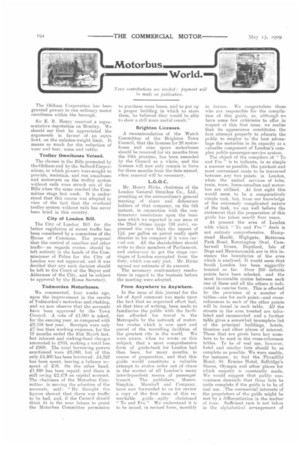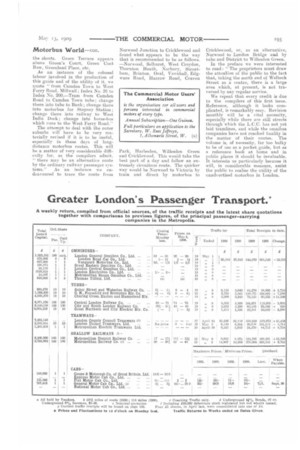Motorbus World.
Page 8

Page 9

If you've noticed an error in this article please click here to report it so we can fix it.
The Oldham Corporation has been granted powers to run ordinary motor omnibuses within the borough.
Sir E. R. Henry received a representative deputation on Monday. We should say that he appreciated the arguments in favour of an extra 5cwt. on the unladen-weight limit. It means so much for the reduction of wear and tear, noise and rattle.
Trolley Omnibuses Vetoed.
The clauses in the Bills promoted by the Oldham and by the Salford Corporations, in which powers were sought to provide, maintain, and run omnibuses and motorcars on the trolley system without rails were struck out of the Bills when the same reached the Committee stage last week. It is understood that this course was adopted in view of the fact that the overhead trolley system without rails has never been tried in this country.
City Of London Bill.
The City of London Bill for the better regulation of street traffic has been considered by a committee of the House of Commons. The proposal that the control of omnibus and other traffic—as regards routes— should be left entirely in the hands of the Commissioner of Police for the City of London was not approved, and it was decided that any such decision should be left to the Court of the Mayor and Aldermen of the City, and be subject to approval by the Home Secretary.
Todmorden Motorbuses.
We commented, four weeks ago, upon the improvement in the results of Todmorden's motorbus unthrtaking, and we now observe that the accounts have been approved by the Town Council. A vote of £1,000 is asked, for the ensuing year, as compared with £2,558 last year. Receipts were only £7 less than working expenses, for the 12 months ended the 31st March last, but interest and sinking-fund charges amounted to £953, making a total loss of £960. The total borrowing powers sanctioned were £6,000, but of this only £4,300 has been borrowed. £4,242 has been spent, leaving a balance urspent of £58. On the other hand. £1.830 has been repaid, and there is still owing £2,478 on capital account. The chairman of the Motorbus Committee. in moving the adoption of the accounts, said: " He thought the figures showed that there was traffic to be had, and, if the Council should think fit in the near future to grant the Motorbus Committee permission to purchase more buses, and to put up a proper building in which to store them, he believed they would be able to show a still more useful result."
Brighton Licenses.
A recommendation of the Watch Committee of the Brighton Town Council, that the licenses for 26 motorbuses and nine spare motorbuses should be renewed for six months from the 10th proximo, has been amended by the Council as a whole, and the licenses will now only remain in force for three months from the date named, when renewal will be necessary.
L.G.O.C.
Mr. Henry Hicks, chairman of the London General Omnibus Co., Ltd., presiding at the extraordinary general meeting of share and debenture holders of that company, on the 6th instant, in connection with the confirmatory resolutions upon the business which we reported in our issue of the 22nd ultimo (page 133 ante), expressed the view that the impost of 11d. per gallon on petrol really spelt disaster to his company if it were cart-red out. All the shareholders sheuld write to their members of Parliament, and endeavour to get the stage carriages of London exempted from the duty, which was only just. Mr. Hicks agreed our estimate of its amount.
The necessary confirmatory resolutions in regard to the business before the meeting were adopted.
From Anywhere to Anywhere.
In the issue of this journal for the 1st of April comment was made upon the fact that no organised effort had, at that time of writing, been made to familiarise the public with the facilities afforded for travel in the Metropolis hy the network of motorbus routes which is now part and parcel of the travelling facilities of the greatest city in the world. We were aware, when we wrote on this subject, that a most comprehensive form of guide-book for London had then been, for many months, in course of preparation, and that this guide would constitute a valuable attempt to evolve order out of chaos in the matter of all London's many interdependent means of passenger transit. The publishers, Messrs. Simpkin, Marshall and Company. have now forwarded to us for review a copy of the first issue of this remarkable guide—aptly christened "To and Fro." We understand it is to be issued, in revised form, monthly
in future. We congratulate those who are responsible for the compilation of this guide, as, although we have some few criticisms to offer in respect of this first issue, we realise that its appearance constitutes the first attempt properly to educate the public to employ to the best advantage the motorbus in its capacity as a valuable component of London's complex public-passenger-service system.
The object of the compilers of " To and Fro " is to indicate, in as simple a manner as possible, the quickest and most convenient route to be traversed between any two points in London, when the united services of tube, train, tram, horse-omnibus and motorbus are utilised. At first sight this would seem to be a comparatively simple task, but, from our knowledge of the extremely complicated nature of the task, we can well believe the statement that the preparation of this guide has taken nearly four years.
At present the area of London with which " To and Fro " deals is not entirely comprehensive. Hampstead Heath, Highgate, Battersea Park Road, Kennington Oval, Camberwell Green, Deptford, Isle of Dogs and Hammersmith are in this instance the boundaries of the area which is analysed. it would seem that South London has been niggardly treated so far. Over 250 definite points have been selected, and the most favourable routes between each one of these and all the others is indicated in concise form. This is effected by the provision of a number of tables—one for each point—and crossreferences to each of the other points will be found in each table. All the streets in the area. treated are tabulated and enumerated, and a further table gives a somewhat incomplete list of the principal buildings, hotels, theatres and other places of interest. Those that are given have key numbers to be used in the cross-reference tables. To be of real use, however, hotel and similar lists should be as complete as possible. We were unable, for instance, to find the Piccadilly Hotel, St. Ermins Hotel, Selfridge's Stores, Olympia and other places for which enquiry is constantly made. We would suggest that public convenience demands that these lists be quite complete if the guide is to be of real use. The commercial interests of the proprietors of the guide might be met by a differentiation in the matter of type. Sufficient care is not taken in the alphabetical arrangement of the sheets. Green Terrace appears above Green's Court, Green Coat Row, Greenland Place, etc.
As an instance of the colossal labour involved in the production of this guide and of the utility of it, we quote " from Camden Town to West Ferry Road, Millwall; Index No. 26 to Index No. 200.-Tram from Camden Road to Camden Town tube; change there into tube to Bank ; change there into motorbus for Stepney Station ; change there into railway to West India Dock ; change into horse-bus which runs to the West Ferry Road." The attempt to deal with the outer suburbs will have to be very materially revised if it is to be useful, especially in these days of longdistance motorbus routes. This will be a matter of very considerable difficulty for, as the compilers admit, " there may be an alternative route by the ordinary railway passenger systems." As an instance we endeavoured to trace the route from Norwood Junction to Cricklewood and found what appears to be the way that is recommended to be as follows. -Norwood, Selhurst, West Croydon, Thornton Heath, Norbury, Streatham, Brixton, Oval, Vanxliall, Edgware Road, Harrow Road, Craven Park, Harlesden, Willesden Green and Cricklewood. This would take the best part of a day and follow an extremely circuitous route. The quicker way would be Norwood to Victoria by train and direct by motorbus to Cricklewood, or, as an alternative, Norwood to London Bridge and by tube and District to Willesden Green.
In the preface we were interested to read : The proprietors must draw the attenlion of the public to the fact that, taking the north end of Welbeck Street as a centre, there is a large area which, at present, is not traversed by any regular service. We repeat that every credit is due to the compilers of this first issue. Reference, although it looks complicated, is remarkably easy. Revision monthly will be a vital necessity, especially while there are still streets through which the L.C.C. has not yet laid tramlines, anti while the omnibus companies have not reached finality in the matter of their routes. The volume is, of necessity, far too bulky to be of use as a pocket guide, but as a reference book at home and in public places it should be invaluable. It interests us particularly because it will, in considerable measure, assist the public to realise the utility of the unadvertised motorbus in London.






















